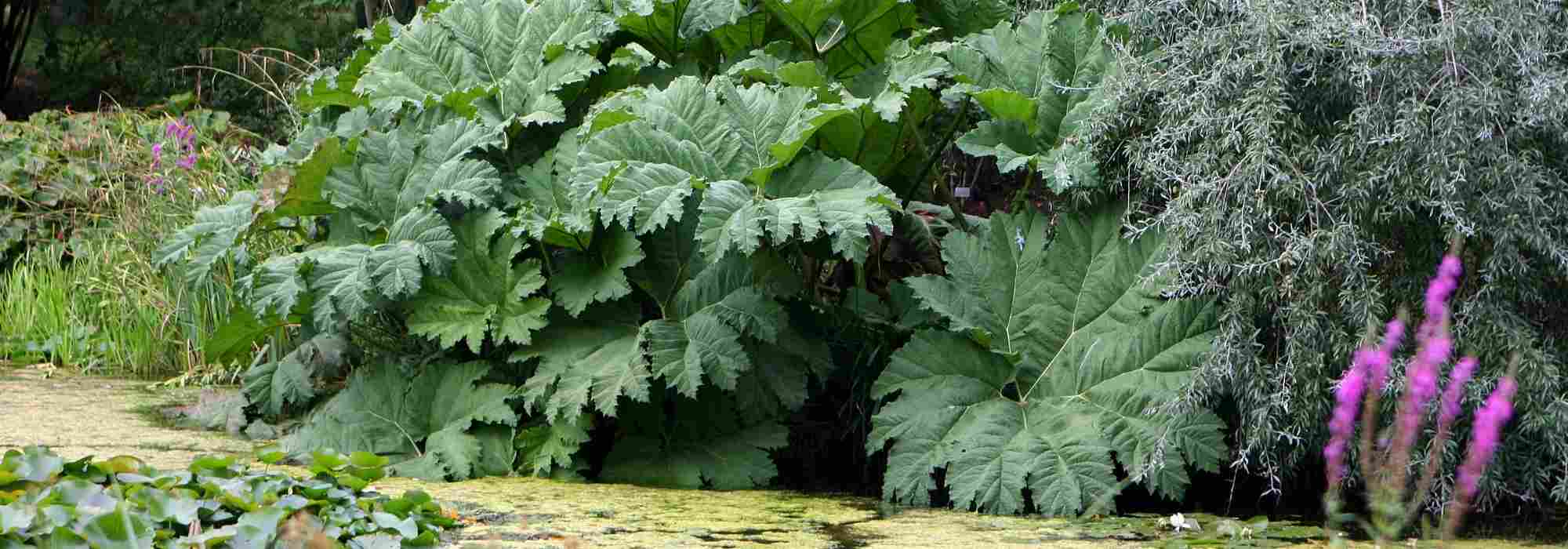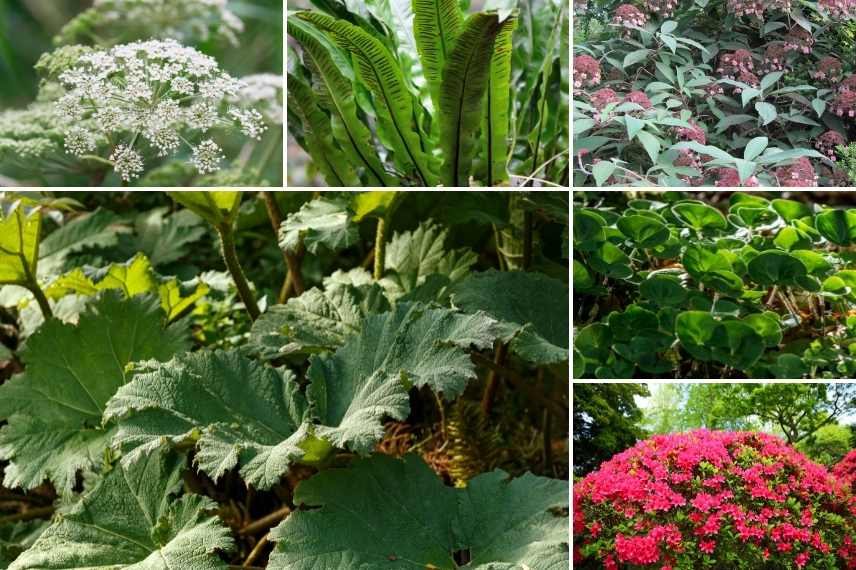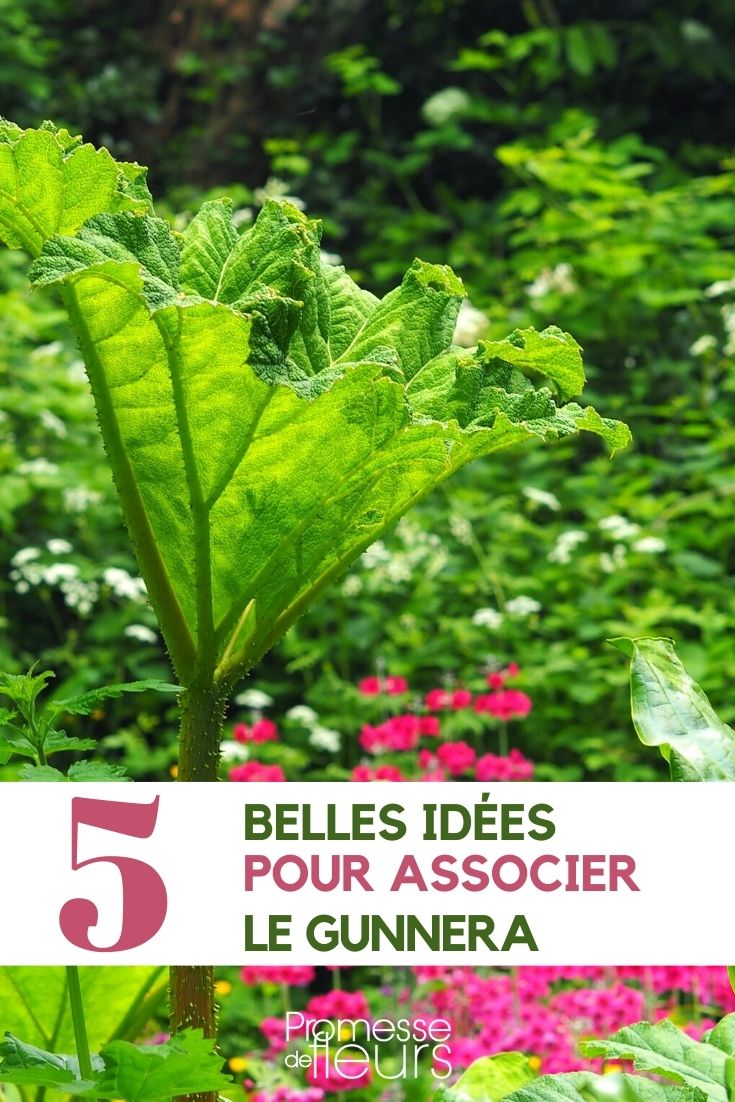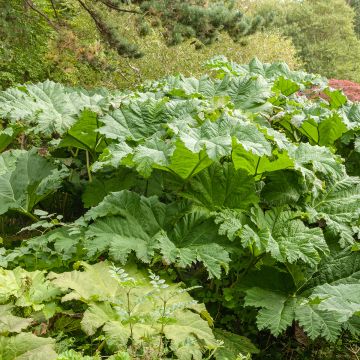
Pairing ideas with Gunnera
How to enhance giant rhubarb in your borders?
Contents
Majestic and graphic plant par excellence, the Gunnera is a remarkable opulent perennial for wet ground. Its giant dimensions make it a plant not so easy to integrate into the garden when there is space to install it, as it tends to overshadow all other surrounding plants with its XXL leaves. It is often seen standing solitary in large parks and botanical gardens, dazzling passers-by with its flamboyance.
At home, it’s a different story, as one wishes to provide a grand setting for this giant rhubarb, without necessarily knowing how to harmoniously associate it with other bushes or perennials. One must consider its needs for moist soil and partial shade to find companions with the same requirements, plants with a strong temperament or original textures to avoid being intimidated by the Brazilian giant.
You will undoubtedly create resolutely exotic beds with Gunnera manicata, featuring lush scenes, abundance around water features, or as a focal point in a foliage bed.
Here are some tips for integrating and associating Brazilian rhubarb in the garden, not forgetting its spreading form, which allows for associations in any garden!
→ Learn more about the Gunnera, Brazilian giant rhubarb: planting and care
In a lush tropical bed
Sculptural, defying all superlatives with its extraordinary dimensions for a perennial herbaceous plant (2m in height and width), Brazilian rhubarb showcases its strong personality best in expansive, lush, and exotic beds! For this jungle atmosphere where it’s impossible to compete with Gunnera, it’s better to opt for plants whose foliage, habit, or colours will provide contrast.
If you have a large area, a vertical element will be useful: palms that thrive in moist soil are welcome, such as Sabals or Trachycarpus fortunei, which are versatile. A Dicksonia antarctica also adds beautiful, feathery texture, which will stand out against the broad leaves of Gunnera manicata. A Tetrapanax can certainly be included, bringing a lot of exoticism, provided you have a very large space to plant; otherwise, these two giants may compete too much…
When it comes to shrubs, it’s always a matter of space, but consider the foliage of Aucubas with variegated leaves that always make a strong impact in an exotic setting, or Brugmansias with their stunning, unusual flowers.
Among the perennials that can provide contrast, there are of course all the ferns that thrive in moist soil, which you can use abundantly, as well as Hostas, banana plants with large foliage, etc. Incorporate exotic-looking blooms in warm colours, with Schizostylis, Hedychiums, or even Hemerocallis, or simply exploit the whiteness and freshness of Arums, without mixing it with other colours.
For a much more minimalist yet equally effective display, Farfugiums planted en masse beautifully accompany Gunnera manicata, offering a lustrous effect with contrasting shiny leaves, and in autumn, a golden yellow carpet at its base.

Gunnera manicata associated with a Sabal minor, a banana plant, a Hedychium coccineum ‘Tara’, Farfugiums, and Arums
The star of a pond
Aquatic plant, Gunnera requires humid environments and constantly cool soils to thrive generously. It is particularly showcased around a water feature – a pond, a small stream, or a large basin – where it benefits from a conducive environment for its exuberance. Be sparing with its companions, as Gunnera will truly take centre stage in this type of setting.
You have two options: create a small basin where you can contain your Gunnera, surrounded by some horsetails (Equisetum japonicum) and submerged plants like Iris pseudoacorus, a clump of Giant Arums (Zantedeschia aethiopica ‘Himalaya’) or a few Ligularias dentata if you wish to incorporate bright flowering.
In a pond or a sufficiently large water feature, opt for some more imposing, graphic, or colourful plants: water lilies and the blooms of water Iris (Iris pseudoacorus) harmoniously complete the decor, while Thalia dealbata submerged will bring their lance-like foliage and summer mauve blooms. Also, plant some Cannas with purple foliage to provide a colour contrast in the foliage, such as the stunning Canna ‘Durban’ or some Eupatoriums planted in groups for a beautiful splash of colour in summer, creating a more rustic atmosphere. Finally, Juncus effusus ‘Spiralis’ will add a unique touch, in a small or medium basin, with their spiralled stems.

In the centre, Gunnera in an aquatic setting, surrounded by: Thalias, Cannas ‘Durban’, water Irises, and water lilies
Discover other Gunnera
View all →Available in 3 sizes
Available in 1 sizes
Available in 1 sizes
In a foliage bed
When you have enough space in the garden, Gunnera is regal in foliage beds, where shapes, colours, and textures of leaves are prioritised. It brings its undeniable presence for many months. This oversized perennial with rough, crinkled texture is still deciduous, and in many regions, its large leaves disappear or wither during the cold season. Choosing to integrate it as the main structure of such a bed means surrounding it with equally unique plants, not forgetting some evergreens.
In this configuration, start by considering including a much taller element: this could be the original, dark stipe of a Cyathea medullaris or a palm with palmate leaves (a Sabal) or pinnate leaves (Archontophoenix alexandrae). As a structuring and contrasting element, a banana plant can pair beautifully with your imposing Gunnera, just like a clump of bamboos nearby for a wonderfully exotic effect.
Many perennials can then naturally fit in such as Zantedeschia aethiopica, Petasites japonicus with its large leaves, Rodgersias chosen in bronze or dark tones like ‘Irish Bronze’, as well as vibrant Ligularias in full summer bloom. It is indeed possible to integrate vegetation that will flower at some point, provided it is chosen sparingly and in light tones that complement each other, such as white or yellow.
Some grasses for moist soil with linear foliage will look stunning within such a foliage bed, adding a more elongated visual: Carex comans ‘Milk Chocolate’ is interesting for its orange reflections in autumn, Carex pendula which is very natural, Cyperus longus, a hardy variety, or Miscanthus sinensis ‘Gracillimus’.

In a large foliage bed, a Gunnera with some ligularias at its feet, and around it, bamboos, Cyathea medullaris, and banana plants
In a wild scene
Provided that there are a few trees to provide some beneficial shade for the Gunnera, especially south of the Loire, it proves to be a very attractive subject within a wild scene in large gardens. For this use, the Gunnera pairs wonderfully with very natural plants, either with a soft or upright habit, sufficiently ample to create a beautiful opulent scene, possessing both graphic qualities and a touch of exoticism.
By choosing plants originating from forest or mountainous environments, such as Angelica sylvestris, exotic-looking bushes like Aralias, evergreen ferns, or remarkable ferns like the giant Osmunda regalis, Persicarias to add a long touch of subtle colour, and a few bushes like Hydrangeas aspera or a generous Hydrangea heteromalla, which are particularly suited for this atmosphere, you create a setting that appears truly spontaneous. Here too, a graphic tree fern will find its place, along with Chinese Azaleas, Astilbes, and groundcover vegetation made up of Anemopsis californica and Asarums.

Angelica sylvestris, Asplenium scolopendrium, Hydrangea aspera villosa (© Leonora Enking), Asarums and Azaleas accompany a Gunnera
As a groundcover in borders or rockeries
It may seem unlikely given the oversized nature of the most well-known species, Gunnera manicata, but the genus Gunnera includes a lesser-known dwarf species that spreads beautifully as a groundcover: Gunnera magellanica.
Thanks to this remarkable, atypical perennial that resembles a truly miniature Gunnera (it reaches no more than 15 cm in height), you can create lovely fresh scenes in moist borders or semi-shaded rockeries.
Choose slightly taller perennials or grasses with linear foliage or delicate flowers that rise above this glossy green carpet to create a well-defined plant stratum: Carex thriving in moist soil (such as Carex morrowii or Carex elata ‘Aurea’), Hostas, or taller options like Rheum palmatum, and accompany your Gunnera magellanica with bank perennials such as Sysirinchium, which will brighten the area with their lovely blue or cream flowers, or with spring Trollius and some clumps of Scirpus cernuus.
A carpet of Helxine next to the mass of Gunneras will provide a beautiful contrast of textures, just like Sagina subulata or a Mauritius lawn (Zoysia tenuifolia).

Gunnera magellanica associated with Helxine and ferns, Trollius, Carex morrowii, and some Hostas
Learn more about Gunnera
Discover the video by Michaël and Olivier on the Gunnera!
- Subscribe!
- Contents



































Comments